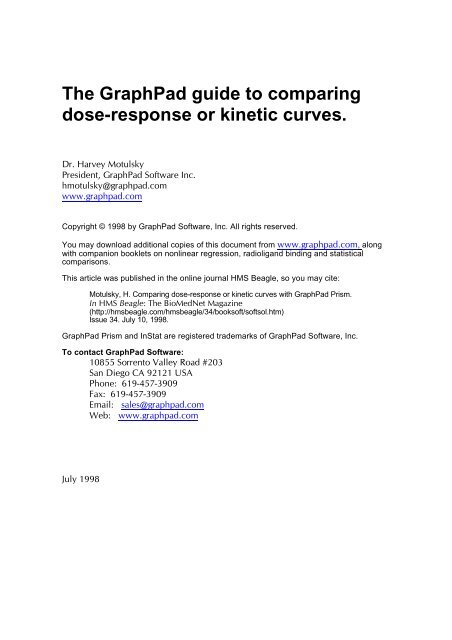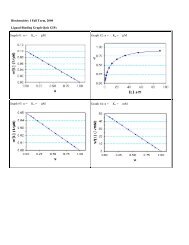The GraphPad guide to comparing dose-response or kinetic curves.
The GraphPad guide to comparing dose-response or kinetic curves.
The GraphPad guide to comparing dose-response or kinetic curves.
You also want an ePaper? Increase the reach of your titles
YUMPU automatically turns print PDFs into web optimized ePapers that Google loves.
<strong>The</strong> <strong>GraphPad</strong> <strong>guide</strong> <strong>to</strong> <strong>comparing</strong><br />
<strong>dose</strong>-<strong>response</strong> <strong>or</strong> <strong>kinetic</strong> <strong>curves</strong>.<br />
Dr. Harvey Motulsky<br />
President, <strong>GraphPad</strong> Software Inc.<br />
hmotulsky@graphpad.com<br />
www.graphpad.com<br />
Copyright © 1998 by <strong>GraphPad</strong> Software, Inc. All rights reserved.<br />
You may download additional copies of this document from www.graphpad.com, along<br />
with companion booklets on nonlinear regression, radioligand binding and statistical<br />
comparisons.<br />
This article was published in the online journal HMS Beagle, so you may cite:<br />
Motulsky, H. Comparing <strong>dose</strong>-<strong>response</strong> <strong>or</strong> <strong>kinetic</strong> <strong>curves</strong> with <strong>GraphPad</strong> Prism.<br />
In HMS Beagle: <strong>The</strong> BioMedNet Magazine<br />
(http://hmsbeagle.com/hmsbeagle/34/booksoft/softsol.htm)<br />
Issue 34. July 10, 1998.<br />
<strong>GraphPad</strong> Prism and InStat are registered trademarks of <strong>GraphPad</strong> Software, Inc.<br />
To contact <strong>GraphPad</strong> Software:<br />
10855 S<strong>or</strong>ren<strong>to</strong> Valley Road #203<br />
San Diego CA 92121 USA<br />
Phone: 619-457-3909<br />
Fax: 619-457-3909<br />
Email: sales@graphpad.com<br />
Web: www.graphpad.com<br />
July 1998
Introduction<br />
Statistical tests are often used <strong>to</strong> test whether the effect of an experimental<br />
intervention is statistically significant. Different tests are used f<strong>or</strong> different kinds of<br />
data – t tests <strong>to</strong> compare measurements, chi-square test <strong>to</strong> compare prop<strong>or</strong>tions, the<br />
logrank test <strong>to</strong> compare survival <strong>curves</strong>. But with many kinds of experiments, each<br />
result is a curve, often a <strong>dose</strong>-<strong>response</strong> curve <strong>or</strong> a <strong>kinetic</strong> curve (time course). This<br />
article explains how <strong>to</strong> compare two <strong>curves</strong> <strong>to</strong> determine if an experimental<br />
intervention altered the curve significantly.<br />
When planning data analyses, you need <strong>to</strong> pick an approach that that matches your<br />
experimental design and whose answer best matches the biological question you<br />
are asking. This article explains six approaches.<br />
In most cases, you’ll repeat the experiment several times, and then want <strong>to</strong> analyze<br />
the pooled data. <strong>The</strong> first step is <strong>to</strong> focus on what you really want <strong>to</strong> know. F<strong>or</strong><br />
<strong>dose</strong>-<strong>response</strong> <strong>curves</strong>, you may want <strong>to</strong> test whether the two EC50 values differ<br />
significantly, whether the maximum <strong>response</strong>s differ, <strong>or</strong> both. With <strong>kinetic</strong> <strong>curves</strong>,<br />
you’ll want <strong>to</strong> ask about differences in rate constants <strong>or</strong> maximum <strong>response</strong>. With<br />
other kinds of experiments, you may summarize the experiment in other ways,<br />
perhaps as the maximum <strong>response</strong>, the minimum <strong>response</strong>, the time <strong>to</strong> maximum,<br />
the slope of a linear regression line, etc. Or perhaps you want <strong>to</strong> integrate the entire<br />
curve and use area-under-the-curve as an overall measure of cumulative <strong>response</strong>.<br />
Once you’ve summarized each curve as a single value either using nonlinear<br />
regression (approach 1) <strong>or</strong> a m<strong>or</strong>e general method (approach 2), compare the<br />
<strong>curves</strong> using a t test.<br />
If you have perf<strong>or</strong>med the experiment only once, you’ll probably wish <strong>to</strong> avoid<br />
making any conclusions until the experiment is repeated. But it is still possible <strong>to</strong><br />
compare two <strong>curves</strong> from one experiment using approaches 3-6. Approaches 3 and<br />
4 require that you fit the curve using nonlinear regression. Approach 3 focuses on<br />
one variable and approach 4 on <strong>comparing</strong> entire <strong>curves</strong>. Approach 5 compares<br />
two linear regression lines. Approach 6 uses two-way ANOVA <strong>to</strong> compare <strong>curves</strong><br />
without the need <strong>to</strong> fit a model with nonlinear regression, and is useful when you<br />
have <strong>to</strong>o few <strong>dose</strong>s (<strong>or</strong> time points) <strong>to</strong> fit <strong>curves</strong>. This method is very general, but<br />
the questions it answers may not be the same as the questions you asked when<br />
designing the experiment.<br />
This flow chart summarizes the six approaches:<br />
<strong>GraphPad</strong> Guide <strong>to</strong> Comparing Curves. Page 2 of 13
Have you perfromed<br />
the experiment m<strong>or</strong>e<br />
than once?<br />
Yes<br />
Can you fit the data<br />
<strong>to</strong> a model with<br />
linear <strong>or</strong> nonlinear<br />
regression?<br />
Yes<br />
No<br />
Œ<br />
No, Once<br />
Can you fit the data<br />
<strong>to</strong> a model with<br />
linear regression,<br />
nonlinear regression,<br />
<strong>or</strong> neither?<br />
Nonlin<br />
Do you care about a<br />
single best-fit<br />
variable? Or do you<br />
want <strong>to</strong> compare the<br />
entire <strong>curves</strong>?<br />
Variable<br />
Curve<br />
Ž<br />
Linear<br />
Neither<br />
‘<br />
Approach 1. Pool several experiments using a best-fit parameter<br />
from nonlinear regression<br />
<strong>The</strong> first step is <strong>to</strong> fit each curve using nonlinear regression, and <strong>to</strong> tabulate the bestfit<br />
values f<strong>or</strong> each experiment. <strong>The</strong>n compare the best-fit values with a paired t test.<br />
F<strong>or</strong> example, here are results of a binding study <strong>to</strong> determine recep<strong>to</strong>r number<br />
(Bmax). <strong>The</strong> experiment was perf<strong>or</strong>med three times with control and treated cells<br />
side-by-side. Here are the data:<br />
Experiment Bmax (sites/cell) Control Bmax (sites/cell) Treated<br />
1 1234 987<br />
2 1654 1324<br />
3 1543 1160<br />
Because the control and treated cells were handled side-by-side, analyze the data<br />
using a paired t test. Enter the data in<strong>to</strong> <strong>GraphPad</strong> InStat, <strong>GraphPad</strong> Prism (<strong>or</strong> some<br />
other statistics program) and choose a paired t test. <strong>The</strong> program rep<strong>or</strong>ts that the<br />
two-tailed P value is 0.0150, so the effect of the treatment on reducing recep<strong>to</strong>r<br />
number is statistically significant. <strong>The</strong> 95% confidence interval of the decrease in<br />
recep<strong>to</strong>r number ranges from 149.70 <strong>to</strong> 490.30 sites/cell.<br />
If you want <strong>to</strong> do the calculations by hand first compute the difference between<br />
Treated and Control f<strong>or</strong> each experiment. <strong>The</strong>n calculate the mean and SEM of<br />
those differences. <strong>The</strong> ratio of the mean difference (320.0) divided by the SEM of<br />
the differences (39.57) equals the t ratio (8.086). <strong>The</strong>re are 2 degrees of freedom<br />
(number of experiments minus 1). You could then use a statistical table <strong>to</strong><br />
determine that the P value is less than 0.05.<br />
<strong>GraphPad</strong> Guide <strong>to</strong> Comparing Curves. Page 3 of 13
<strong>The</strong> nonlinear regression program also determined Kd f<strong>or</strong> each curve (a measure of<br />
affinity), along with the Bmax. Repeat the paired t test with the Kd values if you are<br />
also interested in testing f<strong>or</strong> differences in recep<strong>to</strong>r affinity. (Better, compare the<br />
log(Kd) values, as the difference between logs equals the log of the ratio, and it is<br />
the ratio of Kd values you really care about.)<br />
<strong>The</strong>se calculations were based only on the best-fit values from each experiment,<br />
ign<strong>or</strong>ing all the other results calculated by the curve-fitting program. You may be<br />
concerned that you are not making best use of the data, since the number of points<br />
and replicates do not appear <strong>to</strong> affect the calculations. But they do contribute<br />
indirectly. You’ll get m<strong>or</strong>e accurate fits in each experiment if you use m<strong>or</strong>e<br />
concentrations of ligand (<strong>or</strong> m<strong>or</strong>e replicates). <strong>The</strong> best-fit results of the experiments<br />
will be m<strong>or</strong>e consistent, which increases your power <strong>to</strong> detect differences between<br />
control and treated <strong>curves</strong>. So you do benefit from collecting m<strong>or</strong>e data, even<br />
though the number of points in each curve does not directly enter the calculations.<br />
One of the assumptions of a t test is that the uncertainty in the best-fit values follows<br />
a bell-shaped (Gaussian) distribution. <strong>The</strong> t tests are fairly robust <strong>to</strong> violations of this<br />
assumption, but if the uncertainty is far from Gaussian, the P value from the test can<br />
be misleading. If you fit your data <strong>to</strong> a linear equation using linear regression <strong>or</strong><br />
polynomial regression, this isn’t a problem. With nonlinear equations, the<br />
uncertainty may not be Gaussian. <strong>The</strong> only way <strong>to</strong> know whether the assumption<br />
has been violated is <strong>to</strong> simulate many data (with random scatter), fit each simulated<br />
data set, and then examine the distribution of best-fit values. With reasonable data<br />
(not <strong>to</strong>o much scatter), a reasonable number of data points, and equations<br />
commonly used by biologists, the distribution of best-fit values is not likely <strong>to</strong> be far<br />
from Gaussian. If you are w<strong>or</strong>ried about this, you could use a nonparametric Mann-<br />
Whitney test instead of a t test.<br />
Approach 2. Pool several experiments without nonlinear regression<br />
With some experiments you may not be able <strong>to</strong> choose a model, so can’t fit a curve<br />
with nonlinear regression. But even so, you may be able <strong>to</strong> summarize each<br />
experiment with a single value. F<strong>or</strong> example, you could summarize each curve by<br />
the peak <strong>response</strong>, the time (<strong>or</strong> <strong>dose</strong>) <strong>to</strong> peak, the minimum <strong>response</strong>, the difference<br />
between the maximum and minimum <strong>response</strong>s, the <strong>dose</strong> <strong>or</strong> time required <strong>to</strong><br />
increase the measurement by a certain amount, <strong>or</strong> some other value. Pick a value<br />
that matches the biological question you are asking. One particularly useful<br />
summary is the area under the curve, which quantifies cumulative <strong>response</strong>.<br />
Once you have summarized each curve as a single value, compare treatment<br />
groups with a paired t test. Use the same computations shown in approach 1, but<br />
enter the area under the curve, peak height, <strong>or</strong> some other value instead of Bmax .<br />
<strong>GraphPad</strong> Guide <strong>to</strong> Comparing Curves. Page 4 of 13
Approach 3. Analyze one experiment with nonlinear regression.<br />
Compare best-fit values of one variable.<br />
Even if you have only perf<strong>or</strong>med the experiment only once, you can still compare<br />
<strong>curves</strong> with a t test. A t test compares a difference with the standard err<strong>or</strong> of that<br />
difference. In approaches 2 and 3, the standard err<strong>or</strong> was computed by pooling<br />
several experiments. With approach 3, you use the standard err<strong>or</strong> rep<strong>or</strong>ted by the<br />
nonlinear regression program. F<strong>or</strong> example, in the first experiment in Approach 1,<br />
Prism rep<strong>or</strong>ted these results f<strong>or</strong> Bmax:<br />
Best-fit Bmax SE df<br />
Control 1234 98 14<br />
Treated 987 79 14<br />
You can compare these values, obtained from one experiment, with an unpaired t<br />
using InStat <strong>or</strong> Prism (<strong>or</strong> any statistical program that can compute t tests from<br />
averaged data). Which values do you enter? Enter the best-fit value of the Bmax as<br />
“mean” and the SE of the best-fit value as “SEM”. Choosing a value <strong>to</strong> enter f<strong>or</strong> N is<br />
a bit tricky. <strong>The</strong> t test program really doesn’t need sample size (N). What it needs is<br />
the number of degrees of freedom, which it computes as N-1. Enter “N=15” in<strong>to</strong><br />
the t test program f<strong>or</strong> each group. <strong>The</strong> program will calculate DF as N-1, so will<br />
compute the c<strong>or</strong>rect P value. <strong>The</strong> two-tailed P value is 0.0597. Using the<br />
conventional threshold of P=0.05, the difference between Bmax values in this<br />
experiment is not statistically significant.<br />
To calculate the t test by hand, calculate<br />
1234 - 987<br />
t =<br />
= 1.962<br />
2 2<br />
98 + 79<br />
<strong>The</strong> numera<strong>to</strong>r is the difference between best-fit Bmax values. <strong>The</strong> denomina<strong>to</strong>r is the<br />
standard err<strong>or</strong> of that difference. Since the two experiments were done with the<br />
same number of data points, this equals the square root of the sum of the square of<br />
the two SE values. If the experiments had different numbers of data points, you’d<br />
need <strong>to</strong> weight the SE values so the SE from the experiment with m<strong>or</strong>e data (m<strong>or</strong>e<br />
degrees of freedom) gets m<strong>or</strong>e weight. You’ll find the equation in reference 1<br />
(applied <strong>to</strong> exactly this problem) <strong>or</strong> in almost any statistics book in the chapter on<br />
unpaired t tests.<br />
<strong>The</strong> nonlinear regression program states the number of degrees of freedom f<strong>or</strong> each<br />
curve. It equals the number of data points minus the number of variables fit by<br />
nonlinear regression. In this example, there were eight concentrations of<br />
radioligand in duplicate, and the program fits two variables (Bmax and Kd). So there<br />
were 8*2 – 2 <strong>or</strong> 14 degrees of freedom f<strong>or</strong> each curve, so 28 df in all. You can find<br />
the P value from an appropriate table, a program such as StatMate, <strong>or</strong> by typing this<br />
equation in<strong>to</strong> an empty cell in Excel =TDIST(1.962, 28, 2) . <strong>The</strong> first parameter is<br />
<strong>GraphPad</strong> Guide <strong>to</strong> Comparing Curves. Page 5 of 13
the value of t; the second parameter is the number of df, and the third parameter is<br />
2 because we want a two-tailed P value.<br />
Prism rep<strong>or</strong>ts the best-fit value f<strong>or</strong> each parameter along with a measure of<br />
uncertainty, which it labels the standard err<strong>or</strong>. Some other programs label this the<br />
SD. When dealing with raw data, the SD and SEM are very different – the SD<br />
quantifies scatter, while the SEM quantifies how close your calculated (sample)<br />
mean is likely <strong>to</strong> be <strong>to</strong> the true (population) mean. <strong>The</strong> SEM is the standard<br />
deviation of the mean, which is different than the standard deviation of the values.<br />
When looking at best-fit values from regression, there is no distinction between SE<br />
and SD. So even if your program labels the uncertainty value “SD”, you don’t need<br />
<strong>to</strong> do any calculations <strong>to</strong> convert it <strong>to</strong> a standard err<strong>or</strong>.<br />
Approach 4. Analyze one experiment with nonlinear regression.<br />
Compare entire <strong>curves</strong>.<br />
Approach 3 requires that you focus on one variable that you consider most relevant.<br />
If you care about several variables, you can repeat the analysis with each variable fit<br />
by nonlinear regression. An alternative is <strong>to</strong> compare the entire <strong>curves</strong>. Follow this<br />
approach.<br />
1. Fit the two data sets separately <strong>to</strong> an appropriate equation, just like you did in<br />
Approach 3.<br />
2. Total the sum-of-squares and df from the two fits. Add the sum-of-squares from<br />
the control data with the sum-of-squares of the treated data. If your program<br />
rep<strong>or</strong>ts several sum-of-squares values, sum the residual (sometimes called err<strong>or</strong>)<br />
sum-of-squares. Also add the two df values. Since these values are obtained by<br />
fitting the control and treated data separately, label these values, SSseparate and<br />
DFseparate. F<strong>or</strong> our example, the sums-of-squares equal 1261 and 1496 so SSseparate<br />
equals 2757. Each experiment had 14 degrees of freedom, so DFseparate equals<br />
28.<br />
3. Combine the control and treated data set in<strong>to</strong> one big data set. Simply append<br />
one data set under the other, and analyze the data as if all the values came from<br />
one experiment. Its ok that X values are repeated. F<strong>or</strong> the example, you could<br />
either enter the data as eight concentrations in quadruplicate, <strong>or</strong> as 16<br />
concentrations in duplicate. You’ll get the same results either way, , provided<br />
that you configure the nonlinear regression program <strong>to</strong> treat each replicate as a<br />
separate data point.<br />
4. Fit the combined data set <strong>to</strong> the same equation. Call the residual sum-of-squares<br />
from this fit SScombined and call the number of degrees of freedom from this fit<br />
DFcombmined. F<strong>or</strong> this example, SScombined is 3164 and DFcombmined is 30 (32 data<br />
points minus two variables fit by nonlinear regression).<br />
5. You expect SSseparate <strong>to</strong> be smaller than SScombined even if the treatment had no<br />
effect simply because the separate <strong>curves</strong> have m<strong>or</strong>e degrees of freedom. If the<br />
two data sets are really different, then the pooled curve will be far from most of<br />
the data and SScombined will be much larger than SSseparate. <strong>The</strong> question is whether<br />
<strong>GraphPad</strong> Guide <strong>to</strong> Comparing Curves. Page 6 of 13
the difference between SS values is greater than you’d expect <strong>to</strong> see by chance.<br />
To find out, compute the F ratio using the equation below, and then determine<br />
the c<strong>or</strong>responding P value (there are DFcombined-DFseparate degrees of freedom in the<br />
numera<strong>to</strong>r and DFseparate degrees of freedom in the denomina<strong>to</strong>r.<br />
( SScombined<br />
− SSseparate<br />
) ( DFcombined<br />
− DFseparate<br />
)<br />
F =<br />
SSseparate<br />
DF<br />
F<strong>or</strong> the example, F=2.067 with 2 df in the numera<strong>to</strong>r and 28 in the denomina<strong>to</strong>r.<br />
To find the P value, use a program like <strong>GraphPad</strong> StatMate, find a table in a<br />
statistics book, <strong>or</strong> type this f<strong>or</strong>mula in<strong>to</strong> an empty cell in Excel =FDIST(2.067,2,28)<br />
. <strong>The</strong> P value is 0.1463.<br />
<strong>The</strong> P value tests the null hypothesis that there is no difference between the control<br />
and treated <strong>curves</strong> overall, and any difference you observed is due <strong>to</strong> chance. If the<br />
P value were small, you would conclude that the two <strong>curves</strong> are different – that the<br />
experimental treatment altered the curve. Since this method compares the entire<br />
curve, it doesn’t help you focus on which parameter(s) differ between control and<br />
treated (unless, of course, you only fit one variable). It just tells you that the <strong>curves</strong><br />
differ overall. If you want <strong>to</strong> focus on a certain variable, such as the EC50 <strong>or</strong><br />
maximum <strong>response</strong>, then you should use a method that compares those variables.<br />
Approach 4 compares entire <strong>curves</strong>, so the results can be hard <strong>to</strong> interpret.<br />
In this example, the P value was fairly large, so we conclude that the treatment did<br />
not affect the <strong>curves</strong> in a statistically significant manner.<br />
separate<br />
Approach 5. Compare linear regression lines<br />
If your data f<strong>or</strong>m straight lines, you can fit your data using linear regression, rather<br />
than nonlinear regression. JH Zar discusses how <strong>to</strong> compare linear regression lines<br />
in reference 2. Here is a summary of his approach:<br />
First compare the slopes of the two linear regression lines using a method similar <strong>to</strong><br />
approach 3 above. Pick a threshold P value (usually 0.05) and decide if the<br />
difference in slopes is statistically significant.<br />
• If the difference between slopes is statistically significant, then conclude that the<br />
two lines are distinct. If relevant, you may wish <strong>to</strong> calculate the point where the<br />
two lines intersect.<br />
• If the difference between slopes is not significant then fit new regression lines<br />
but with the constraint that both must share the same slope. Now ask whether<br />
the difference between the elevation of these two parallel lines is statistically<br />
significant. If so, conclude that the two lines are distinct, but parallel. Otherwise<br />
conclude that the two lines are statistically indistinguishable.<br />
<strong>GraphPad</strong> Guide <strong>to</strong> Comparing Curves. Page 7 of 13
<strong>The</strong> details are tedious, so aren’t repeated here. Refer <strong>to</strong> the references, <strong>or</strong> use<br />
<strong>GraphPad</strong> Prism, which compares linear regression lines au<strong>to</strong>matically.<br />
An alternative approach <strong>to</strong> compare two linear regression lines is <strong>to</strong> use multiple<br />
regression, using a dummy variable <strong>to</strong> denote treatment group. This approach is<br />
explained in reference 3, which also describes, in detail, how <strong>to</strong> compare slopes<br />
and intercepts without multiple regression.<br />
Approach 6. Comparing <strong>curves</strong> with ANOVA<br />
If you don’t have enough data points <strong>to</strong> allow curve fitting, <strong>or</strong> if you don’t want <strong>to</strong><br />
choose a model (equation), you can analyze the data using two-way analysis of<br />
variance (ANOVA) followed by posttests. This method is also called two-fac<strong>to</strong>r<br />
ANOVA (one fac<strong>to</strong>r is <strong>dose</strong> <strong>or</strong> time; the other fac<strong>to</strong>r is experimental treatment).<br />
Here is an example, along with the two-way ANOVA results from Prism.<br />
Dose<br />
0.0<br />
1.0<br />
2.0<br />
Control<br />
Y1 Y2 Y3<br />
23.0<br />
34.0<br />
43.0<br />
25.0<br />
41.0<br />
47.0<br />
29.0<br />
37.0<br />
54.0<br />
Treated<br />
Y1 Y2 Y3<br />
28.0<br />
47.0<br />
65.0<br />
31.0<br />
54.0<br />
60.0<br />
26.0<br />
56.0<br />
75<br />
Response<br />
50<br />
25<br />
0<br />
Control<br />
Treated<br />
0 1 2<br />
Dose<br />
Source of Variation<br />
Interaction<br />
Treatment<br />
Dose<br />
P value<br />
0.0384<br />
0.0002<br />
P
Two-way ANOVA computes three P values.<br />
• <strong>The</strong> P value f<strong>or</strong> interaction tests the null hypothesis that the effect of treatment is<br />
the same at all <strong>dose</strong>s (<strong>or</strong>, equivalently, that the effect of <strong>dose</strong> is the same f<strong>or</strong><br />
both treatments). This P value is below the usual threshold of 0.05, so you can<br />
conclude that the null hypothesis is unlikely <strong>to</strong> be true. Instead, the effect of<br />
treatment varies significantly with <strong>dose</strong>. <strong>The</strong> <strong>dose</strong>-<strong>response</strong> <strong>curves</strong> are not<br />
parallel.<br />
• <strong>The</strong> P value f<strong>or</strong> treatment tests the null hypothesis that the treatments have no<br />
effect on the <strong>response</strong>. This P value is very low, so you conclude that treatment<br />
did affect <strong>response</strong> on average. <strong>The</strong> <strong>dose</strong>-<strong>response</strong> <strong>curves</strong> are not identical.<br />
When the interaction P value is low, it is hard <strong>to</strong> interpret the P value f<strong>or</strong><br />
treatment.<br />
• <strong>The</strong> P value f<strong>or</strong> <strong>dose</strong> tests the null hypothesis that <strong>dose</strong> had no effect on the<br />
<strong>response</strong>. It is very low, so you conclude that <strong>response</strong> varied with <strong>dose</strong>. <strong>The</strong><br />
<strong>dose</strong>-<strong>response</strong> <strong>curves</strong> are not h<strong>or</strong>izontal. When the interaction P value is low, it<br />
is hard <strong>to</strong> interpret the P value f<strong>or</strong> <strong>dose</strong>.<br />
Since the treatment had a significant effect, and had a different effect at different<br />
<strong>dose</strong>s, you may now wish <strong>to</strong> perf<strong>or</strong>m posttests <strong>to</strong> determine at which <strong>dose</strong>s the<br />
effect of treatment is statistically significant. <strong>The</strong> current version (2.0) of <strong>GraphPad</strong><br />
Prism does not perf<strong>or</strong>m any posttests following two-way ANOVA, but the next<br />
version (3.0) will. Other ANOVA programs perf<strong>or</strong>m posttests, but often not the<br />
posttests you need <strong>to</strong> compare <strong>dose</strong>-<strong>response</strong> <strong>curves</strong>. Instead, most programs pool<br />
the control and treated values <strong>to</strong> determine the mean <strong>response</strong> at each <strong>dose</strong>, and<br />
then perf<strong>or</strong>m posttests <strong>to</strong> compare the average <strong>response</strong> at one <strong>dose</strong> with the<br />
average <strong>response</strong> at another <strong>dose</strong>. This approach is useful in many contexts, but not<br />
when <strong>comparing</strong> <strong>dose</strong>-<strong>response</strong> <strong>or</strong> <strong>kinetic</strong> <strong>curves</strong>. F<strong>or</strong>tunately, it is fairly<br />
straightf<strong>or</strong>ward <strong>to</strong> perf<strong>or</strong>m the posttest calculations by hand.<br />
Your first temptation may be <strong>to</strong> perf<strong>or</strong>m a separate t test at each <strong>dose</strong>, but this<br />
approach is not appropriate. Instead, compute posttests as explained in reference 4.<br />
At each <strong>dose</strong> (<strong>or</strong> time point), compute:<br />
t =<br />
mean − mean<br />
MS<br />
1<br />
residual<br />
⎛ 1<br />
⎜<br />
⎝ N<br />
1<br />
2<br />
1<br />
+<br />
N<br />
2<br />
⎞<br />
⎟<br />
⎠<br />
<strong>The</strong> numera<strong>to</strong>r is the mean <strong>response</strong> in one group minus the mean <strong>response</strong> at the<br />
other group, at a particular <strong>dose</strong> (<strong>or</strong> time point). <strong>The</strong> mean is computed from<br />
replicate values at one <strong>dose</strong> (<strong>or</strong> time) from one treatment group. <strong>The</strong> denomina<strong>to</strong>r<br />
combines the number of replicates in the control and treated samples at that <strong>dose</strong><br />
with the mean square of the residuals (sometimes called the mean square of the<br />
<strong>GraphPad</strong> Guide <strong>to</strong> Comparing Curves. Page 9 of 13
err<strong>or</strong>), which is a pooled measure of variability at all <strong>dose</strong>s. One of the assumptions<br />
of two-way ANOVA is that the variability (experimental err<strong>or</strong>) is the same f<strong>or</strong> each<br />
<strong>dose</strong> f<strong>or</strong> each treatment. If this is not a reasonable assumption, you may be able <strong>to</strong><br />
transf<strong>or</strong>m the values – perhaps as logarithms – so it is. If you assume that the<br />
variability is the same f<strong>or</strong> all <strong>dose</strong>s and all treatments, then it makes sense <strong>to</strong> pool<br />
all the variability in<strong>to</strong> one number, the MSresidual. Some programs call this value<br />
MSerr<strong>or</strong>.<br />
In the example, MSresidual equals 15.92, a value you can read off the ANOVA table.<br />
Here are the results at each of the three <strong>dose</strong>s. <strong>The</strong> means and sample sizes are<br />
computed directly from the data table shown above, and the t ratio is then<br />
computed f<strong>or</strong> each <strong>dose</strong>.<br />
Dose Mean 1 Mean 2 N 1 N 2 t<br />
0 25.7 28.3 3 3 0.8185<br />
1 37.3 52.3 3 3 4.6048<br />
2 48.0 62.5 3 2 3.9809<br />
Which of these differences are statistically significant? To find out, we need <strong>to</strong> know<br />
the value of t that c<strong>or</strong>responds <strong>to</strong> P=0.05, c<strong>or</strong>recting f<strong>or</strong> the fact that we are making<br />
three comparisons. You can get this critical t value from Excel by typing this<br />
f<strong>or</strong>mula in<strong>to</strong> a blank cell: =TINV(0.05/3, 11) . <strong>The</strong> first parameter is the<br />
probability. We entered 0.05/3, because we wanted <strong>to</strong> set α <strong>to</strong> its conventional<br />
value of 0.05, but adjusted <strong>to</strong> account f<strong>or</strong> three simultaneous comparisons (there<br />
were three <strong>dose</strong>s in this example). You could enter a different value than 0.05 <strong>or</strong> a<br />
different number of <strong>dose</strong>s (<strong>or</strong> time points). <strong>The</strong> second parameter is the degrees of<br />
freedom, which you can see on the ANOVA table (df f<strong>or</strong> residuals). <strong>The</strong> critical t<br />
value is 2.8200.<br />
<strong>The</strong> t ratio at time 0 is less than 2.82, so that difference is not statistically significant.<br />
<strong>The</strong> t ratio at the other two times are greater than 2.82, so are significant at the 0.05<br />
level, c<strong>or</strong>recting f<strong>or</strong> multiple comparisons. <strong>The</strong> threshold t ratio f<strong>or</strong> significance at<br />
the 0.01 level is computed as TINV(0.01/3,11) which equals 3.728. <strong>The</strong> differences<br />
at <strong>dose</strong>s 1 and 2 are significant at the 0.01 level. <strong>The</strong> t ratio f<strong>or</strong> significance at the<br />
0.001 level is 5.120, so none of the differences are significant at the 0.001 level.<br />
<strong>The</strong> value 5% refers <strong>to</strong> the entire family of comparisons, not <strong>to</strong> each individual<br />
comparison. If the treatment had no effect, there is a 5% chance that random<br />
variability in your data would result in a statistically significant difference at any one<br />
<strong>or</strong> m<strong>or</strong>e <strong>dose</strong>s, and thus a 95% chance that the treatment would have a<br />
nonsignificant effect at all <strong>dose</strong>s. This c<strong>or</strong>rection f<strong>or</strong> multiple comparisons uses the<br />
method of Bonferroni (divide 0.05 by the number of comparisons).<br />
<strong>GraphPad</strong> Guide <strong>to</strong> Comparing Curves. Page 10 of 13
You can also calculate a confidence interval f<strong>or</strong> the difference between control and<br />
treated values at each <strong>dose</strong> using this equation:<br />
*<br />
⎛ 1 1 ⎞<br />
*<br />
⎛ 1 1 ⎞<br />
(mean − ⋅<br />
⎜ +<br />
⎟<br />
− + ⋅<br />
⎜ +<br />
⎟<br />
2<br />
mean1)<br />
- t MSresidual<br />
<strong>to</strong> (mean<br />
2<br />
mean1)<br />
t MSresidual<br />
⎝ N1<br />
N<br />
2 ⎠<br />
⎝ N1<br />
N<br />
2 ⎠<br />
<strong>The</strong> critical value of t is abbreviated t* in that equation (not a standard<br />
abbreviation). Its value was determined above as 2.8200. <strong>The</strong> value depends only<br />
on the number of degrees of freedom and the degree of confidence you want.<br />
You’d get a different value f<strong>or</strong> t* if you have a different number of degrees of<br />
freedom. Since that value of t* was determined f<strong>or</strong> a P value of 0.05, it generates<br />
95% confidence intervals (100%-5%). If you picked t* f<strong>or</strong> P=0.01, that value could<br />
be used f<strong>or</strong> 99% confidence intervals.<br />
<strong>The</strong> value of MSresidual is found on the ANOVA table; it equals 15.92. Now you can<br />
calculate the lower and upper confidence limits at each <strong>dose</strong>:<br />
Dose mean 1 Mean 2 N 1 N 2 Lower CL Upper CL<br />
0 25.7 28.3 3 3 -6.59 11.79<br />
1 37.3 52.3 3 3 5.81 24.19<br />
2 48.0 62.5 3 2 4.23 24.77<br />
Because the value of t* used the Bonferroni c<strong>or</strong>rection, these are simultaneous 95%<br />
confidence intervals. You can be 95% sure that all three of those intervals contain<br />
the true effect of treatment at that <strong>dose</strong>. So you can be 95% sure that all three of<br />
these statements are true: <strong>The</strong> effect of <strong>dose</strong> 0 is somewhere between a decrease of<br />
6.59 and an increase of 11.79; <strong>dose</strong> 1 increases <strong>response</strong> between 5.81 and 24.19;<br />
and <strong>dose</strong> 2 increases <strong>response</strong> between 4.23 and 24.77.<br />
Note that this method assumes that the Y1, Y2 and Y3 values entered in<strong>to</strong> the data<br />
table represent triplicate measurements, and that there is no matching. In other<br />
w<strong>or</strong>ds, it assumes that the Y1 measurement f<strong>or</strong> the first time point is not matched <strong>to</strong><br />
the Y1 measurement f<strong>or</strong> the second time point. If all the Y1 measurements are from<br />
matched experiments, <strong>or</strong> from one individual repeatedly measured, then you’ll<br />
need an ANOVA program that can handle repeated measures. You’ll get a different<br />
value f<strong>or</strong> the residual sum-of-squares and degrees of freedom, but can perf<strong>or</strong>m the<br />
posttest in the same way.<br />
Using two-way ANOVA <strong>to</strong> compare <strong>dose</strong>-<strong>response</strong> <strong>curves</strong> presents two problems.<br />
One problem is that ANOVA treats different <strong>dose</strong>s (<strong>or</strong> time points) exactly as it<br />
treats different species <strong>or</strong> different drugs. ANOVA ign<strong>or</strong>es the fact that <strong>dose</strong>s <strong>or</strong> time<br />
points come in <strong>or</strong>der. If you jumbled the <strong>or</strong>der of the <strong>dose</strong>s, you’d get exactly the<br />
same ANOVA results. You did the experiment <strong>to</strong> observe a trend, so you should be<br />
cautious about interpreting results from an analysis method that doesn’t recognize<br />
trends.<br />
<strong>GraphPad</strong> Guide <strong>to</strong> Comparing Curves. Page 11 of 13
Another problem with the ANOVA approach is that it is hard <strong>to</strong> interpret the results.<br />
Knowing at which <strong>dose</strong>s <strong>or</strong> time points the treatment had a statistically significant<br />
effect doesn’t always help you understand the biology of the system, and rarely<br />
helps you design new experiments. Some scientists like <strong>to</strong> ask which is the lowest<br />
<strong>dose</strong> (<strong>or</strong> time) at which the effect of the treatment is statistically significant. <strong>The</strong><br />
posttests give you the answer, but the answer depends on sample size. Run m<strong>or</strong>e<br />
subjects, <strong>or</strong> m<strong>or</strong>e <strong>dose</strong>s <strong>or</strong> time points f<strong>or</strong> each curve, and the answer will change.<br />
This ANOVA method is most useful when you have collected data at only a few<br />
<strong>dose</strong>s <strong>or</strong> time points. F<strong>or</strong> experiments where you collect data at many <strong>dose</strong>s <strong>or</strong> time<br />
points, consider one of the other approaches.<br />
Comparing m<strong>or</strong>e than two <strong>curves</strong><br />
This article focussed on <strong>comparing</strong> two <strong>curves</strong>. If you have several treatment<br />
groups, approaches 1-3 can easily be extended <strong>to</strong> handle three <strong>or</strong> m<strong>or</strong>e groups.<br />
Simple use one-way ANOVA, rather than a t test. Extending approaches 4-6 <strong>to</strong><br />
handle three <strong>or</strong> m<strong>or</strong>e groups is m<strong>or</strong>e difficult, beyond the scope of this article.<br />
Summary<br />
How do you test whether an experimental manipulation changed the <strong>dose</strong>-<strong>response</strong><br />
(<strong>or</strong> some other) curve? This is a common question, but one that requires a long<br />
answer. <strong>The</strong> best approach is <strong>to</strong> summarize each curve with a single value, and<br />
then compare treatment groups with a t test. If you’ve only perf<strong>or</strong>med the<br />
experiment once, you’ll need <strong>to</strong> use another approach and this article lists several.<br />
But you’ll probably want <strong>to</strong> repeat the experiment bef<strong>or</strong>e reaching a strong<br />
conclusion.<br />
<strong>GraphPad</strong> Software<br />
<strong>The</strong> auth<strong>or</strong> of this article is the president of <strong>GraphPad</strong> Software, crea<strong>to</strong>rs of<br />
<strong>GraphPad</strong> Prism and <strong>GraphPad</strong> InStat.<br />
<strong>GraphPad</strong> Prism is a scientific graphics program that is particularly well suited f<strong>or</strong><br />
nonlinear regression:<br />
• Prism provides a menu of commonly used equations (including equations used<br />
f<strong>or</strong> analysis of radioligand binding experiments). To fit a curve, all you have <strong>to</strong><br />
do is pick the right equation. Prism does all the rest au<strong>to</strong>matically, from picking<br />
initial values <strong>to</strong> graphing the curve.<br />
• Prism can au<strong>to</strong>matically compare two models with the F test.<br />
• When analyzing competitive radioligand binding <strong>curves</strong>, Prism au<strong>to</strong>matically<br />
calculates Ki from IC50.<br />
• You can use the best-fit curve as a standard curve. Enter Y values and Prism will<br />
determine X; enter X and Prism will determine Y.<br />
<strong>GraphPad</strong> Guide <strong>to</strong> Comparing Curves. Page 12 of 13
• Prism can au<strong>to</strong>matically graph a residual plot and perf<strong>or</strong>m the runs test.<br />
• Prism’s manual and help screens explain the principles of curve fitting with<br />
nonlinear regression and help you interpret the results. You don’t have <strong>to</strong> be a<br />
statistics expert <strong>to</strong> use Prism.<br />
<strong>GraphPad</strong> InStat is a low-end statistics program. It is so easy <strong>to</strong> use that anyone can<br />
master it in about two minutes – really. InStat helps you choose an appropriate<br />
statistical test and helps you interpret the results. It even shows you an analysis<br />
checklist <strong>to</strong> be sure that you’ve picked an appropriate test.<br />
Please visit <strong>GraphPad</strong>’s web site at http://www.graphpad.com. You can read about<br />
Prism and InStat and download free demos. <strong>The</strong> demos are not slide shows – they<br />
are functional versions of Prism and InStat with no limitations in data analysis. Try<br />
them with your own data, and see f<strong>or</strong> yourself why Prism is the best solution f<strong>or</strong><br />
analyzing and graphing scientific data and why InStat is the w<strong>or</strong>ld’s simplest<br />
statistics program.<br />
While at the web site, browse the <strong>GraphPad</strong> Data Analysis Resource Center. You’ll<br />
find the <strong>GraphPad</strong> Guide <strong>to</strong> Nonlinear Regression and the <strong>GraphPad</strong> Guide <strong>to</strong><br />
Analyzing Radioligand Binding Data, along with sh<strong>or</strong>ter articles. You’ll also find a<br />
radioactivity calcula<strong>to</strong>r and links <strong>to</strong> recommended web sites and books.<br />
References<br />
1. SA Glantz, BK Slinker, Primer of Applied Regression and Analysis of Variance,<br />
McGraw-Hill, 1990. Page 504 explains approach 3, and gives the equation <strong>to</strong><br />
use when the two treatments were analyzed with different numbers of data<br />
points.<br />
2. J Zar, Biostatistical Analysis, 2nd edition, Prentice-Hall, 1984. Chapter 18<br />
explains approach 5.<br />
3. DG Kleinbaum and LL Kupper, Applied Regression Analysis and Other<br />
Mutivariable Methods, Duxbury Press , 1997. Gives the details of approach 5,<br />
and also how <strong>to</strong> compare linear regression lines using multiple regression.<br />
4. J Neter, W Wasserman, MH Kutner, Applied Linear Statistical Models. 3 rd<br />
edition, Irwin, 1990. Pages and 741-744 and 771 explain approach 6.<br />
<strong>GraphPad</strong> Guide <strong>to</strong> Comparing Curves. Page 13 of 13
















